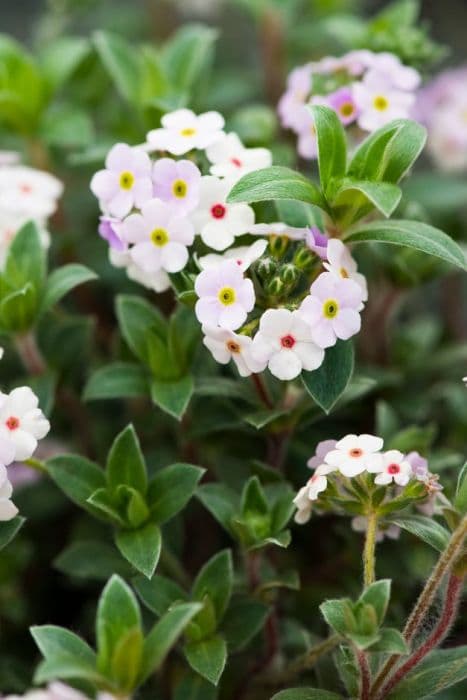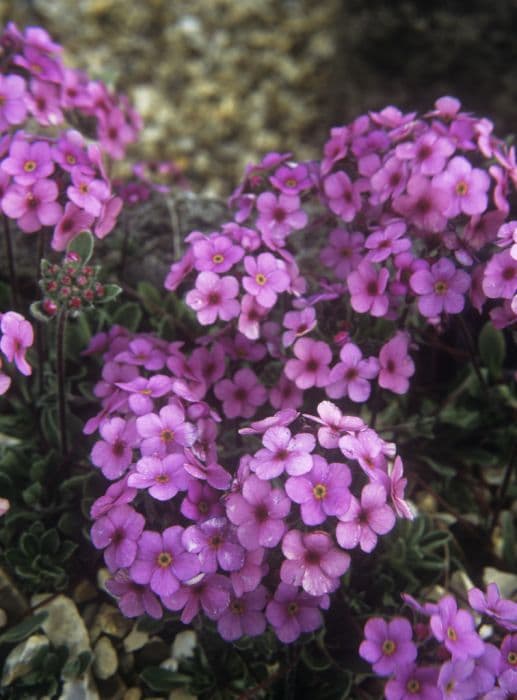Primrose Primula vulgaris 'Avondale' (Kennedy Irish Series) (Pr/prim)

ABOUT
Primula vulgaris 'Avondale' from the Kennedy Irish Series, also widely known as the common primrose, boasts a charming and delicate appearance. Its flowers are particularly captivating, typically showcasing a rich array of colors that may include vibrant yellows to deep purples or reds, each with a distinct, contrasting eye at the center, giving them an aura of depth and complexity. The petals are roundish and may have a slightly ruffled or smooth edge, often forming a simple, yet beautiful, funnel-like shape, which is a hallmark of the common primrose. The foliage of 'Avondale' consists of a dense rosette of leaves that are tender to the touch. Each leaf is oblong to spoon-shaped, with a softly wrinkled texture and a gentle, sometimes wavy, margin, giving them an inviting, lush appearance. These leaves are typically a deep green, providing a striking backdrop for the vivid bloom colors. While the overall structure of the plant is low and spreading, the exact dimensions are excluded from this description. The arrangement of the stems and leaves lends itself to a natural, mounded form that cradles the showy flowers beautifully, allowing them to stand out and capture attention. This particular variety is cherished for its endearing look and its role as a herald of spring, bringing life and color to gardens, borders, and containers.
About this plant
 Names
NamesFamily
Primulaceae
Synonyms
Irish Primrose, Avondale Primrose
Common names
Primula vulgaris 'Avondale'.
 Toxicity
ToxicityTo humans
The Primrose, specifically the Primula vulgaris 'Avondale', is generally considered non-toxic to humans. However, some individuals may experience mild discomfort if they ingest parts of the plant or come into contact with its sap due to the presence of saponins and other irritants. If ingested, symptoms can include mild gastrointestinal upset like nausea or vomiting. Contact with the skin can sometimes cause dermatitis in sensitive individuals. It is always advisable to exercise caution and keep plants out of reach of children who might ingest them.
To pets
The Primrose, including the Primula vulgaris 'Avondale', may cause mild to moderate toxicity if ingested by pets. Symptoms of poisoning in pets, such as cats and dogs, often include vomiting, diarrhea, and drooling. In some cases, ingestion can result in mild dermatitis or an allergic reaction. It is best to keep this plant out of reach of pets to avoid any potential negative effects. If a pet does ingest part of the plant and exhibits symptoms, it is recommended to contact a veterinarian.
 Characteristics
CharacteristicsLife cycle
Perennials
Foliage type
Evergreen
Color of leaves
Green
Flower color
Purple
Height
6 inches (15 cm)
Spread
6 inches (15 cm)
Plant type
Herb
Hardiness zones
5
Native area
Europe
Benefits
 General Benefits
General Benefits- Attractive blooms: Primula vulgaris 'Avondale' produces beautiful, vibrant flowers that add color to gardens and landscapes.
- Extended flowering period: This plant variety typically has a long blooming season that extends from early spring into late spring.
- Ease of care: Primrose is generally easy to grow and maintain, which makes it a great choice for gardeners of all skill levels.
- Hardiness: It is hardy and can tolerate cold temperatures, making it suitable for a variety of climates.
- Ground cover: Primula vulgaris 'Avondale' can serve as an effective ground cover, suppressing weeds and protecting soil.
- Attracts wildlife: The flowers can attract beneficial insects, such as bees and butterflies, which are important for pollination.
- Versatility in landscaping: Primrose can be used in a variety of garden settings, including borders, rock gardens, and woodland gardens.
- Humidity tolerance: This variety of primrose can tolerate humid conditions often found in maritime climates.
- Shade tolerance: It can grow successfully in partially shaded areas, giving options for planting in different garden locations.
 Medical Properties
Medical Properties- This plant is not used for medical purposes.
 Air-purifying Qualities
Air-purifying QualitiesThis plant is not specifically known for air purifying qualities.
 Other Uses
Other Uses- Garden Art: Press the flowers of Primula vulgaris to create natural motifs for greeting cards, bookmarks, or framed botanical art.
- Fairy Gardens: These flowers can be a magical addition to whimsical fairy gardens crafted to spark the imagination and add charm to small spaces.
- Mood Lighting: Float the blooms in a bowl of water with candles for a serene and enchanting table centerpiece.
- Photography: Primula vulgaris can be used as a stunning photography subject, especially for macro photography enthusiasts.
- Educational Tool: In a school setting, these plants can be used to teach children about plant life cycles, pollination, and horticulture.
- Culinary Decoration: Use the non-toxic flowers to decorate cakes and desserts for an attractive and edible garnish.
- Color Dye: The petals can be used to create natural dyes for fabrics, giving them a subtle and unique color.
- Journaling: Nature journalers can press the flowers of Primula vulgaris for their herbarium collection or to embellish their journal pages.
- Window Boxes: This plant can brighten up window boxes with cascades of their colorful blooms for a picturesque look from inside or outside the home.
- Craft Projects: Incorporate Primula vulgaris flowers into craft projects, such as flower pounding to transfer the pigment and patterns onto materials like paper or fabric.
Interesting Facts
 Feng Shui
Feng ShuiThe common primrose is not used in Feng Shui practice.
 Zodiac Sign Compitability
Zodiac Sign CompitabilityThe common primrose is not used in astrology practice.
 Plant Symbolism
Plant Symbolism- Youthful Beauty: The Primrose, with its delicate and vibrant flowers, commonly symbolizes the freshness and innocence of youth.
- Hope and Renewal: Blooming early in the spring, the Primrose is often associated with new beginnings and the hope that comes with the start of a new growing season.
- Eternal Love: In some traditions, giving a Primrose is thought to express an undying love for the recipient, possibly because of its perennial nature.
- Affection: The gentle appearance of the Primrose makes it a symbol of fondness and caring.
 Water
WaterCommon primrose, including the Primula vulgaris 'Avondale', requires consistent moisture and should not be allowed to dry out. Water the plant deeply once a week, providing about one gallon of water per square yard, though this may need to be adjusted depending on climate and soil conditions. During the growing season in spring and summer, increase watering frequency to maintain evenly moist soil. If the weather is exceptionally hot or dry, check the soil moisture more frequently and water as needed. Always water at the base of the plant to keep the foliage dry and reduce the risk of disease.
 Light
LightThe common primrose thrives best in partial shade where it can be protected from the intense midday sun. A spot that receives morning sunlight and afternoon shade, or dappled sunlight throughout the day, is ideal. Avoid placing it in full shade as this can result in less vigorous growth and fewer blooms.
 Temperature
TemperatureCommon primrose prefers cool to moderate temperatures and thrives best when the temperature stays between 50 and 70 degrees Fahrenheit. It can tolerate temperatures as low as 20 degrees Fahrenheit, but not for prolonged periods. The plant can also survive temporary spikes up to 80 degrees Fahrenheit, but prolonged heat can be detrimental.
 Pruning
PruningCommon primrose benefits from deadheading spent flowers to encourage new blooms and maintain a tidy appearance. Prune off any dead or yellowing leaves to prevent disease and promote healthy growth. The best time for pruning is immediately after flowering, and routine deadheading can be done throughout the blooming period.
 Cleaning
CleaningAs needed
 Soil
SoilCommon Primrose requires moist but well-draining soil with a slightly acidic to neutral pH of 6.0-7.0. A good soil mix would be composed of one part garden loam, one part well-rotted compost, and one part perlite or sand to improve drainage. Regularly enrich the soil with organic matter to maintain fertility.
 Repotting
RepottingCommon Primrose should be repotted every 1-2 years to replenish the soil and give the roots new space to grow. The best time for repotting is after the flowering season when the plant is entering a period of new growth.
 Humidity & Misting
Humidity & MistingCommon Primrose thrives best in moderate to high humidity levels, ideally between 50-70%. These plants prefer a humid environment that mimics their natural woodland habitat.
 Suitable locations
Suitable locationsIndoor
Keep in bright, indirect light with high humidity.
Outdoor
Plant in partial shade with moist, well-draining soil.
Hardiness zone
4-8 USDA
 Life cycle
Life cyclePrimula vulgaris 'Avondale', commonly known as Avondale Primrose, begins its life cycle as a seed that, once sown in fertile, well-drained soil, will germinate usually in spring or autumn. Upon germination, the seedling emerges and develops into a small rosette of oval leaves. As it matures, the plant forms a more robust rosette and, in late winter to early spring, sends up flowering stalks with clusters of attractive flowers, varying in shades from purple to blue with a yellow center. After pollination, usually by insects, the flowers will fade and give way to seed capsules which, when ripe, release the seeds to begin a new generation. Throughout the growing season, the plant continues to produce foliage, and it may enter a semi-dormant state in extreme heat or cold, although it is considered evergreen. The plant is perennial, so it will die back seasonally and regrow from its base each year for several years before it may need to be replaced or rejuvenated through division.
 Propogation
PropogationPropogation time
Early spring
Propogation: Primula vulgaris 'Avondale', a cultivar from the Kennedy Irish Series, is commonly known as the 'Avondale' primrose. It can be propagated through division, which is the most popular method for this perennial. Division is best done in the spring or early fall when the plant is not in active bloom. To propagate by division, carefully lift the plant from the ground using a garden fork, ensuring a good amount of roots are kept intact. Gently tease apart individual crowns, each with their own root system, making sure each new section has at least two or three healthy leaves. These divisions can then be replanted at the same depth they were originally growing, spaced about 6 to 12 inches (15 to 30 centimeters) apart to allow for growth, and watered well to help establish them. This method of propagation helps to rejuvenate older clumps and also provides a way to increase your stock of plants efficiently.









